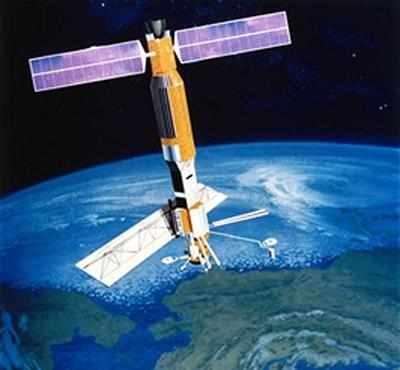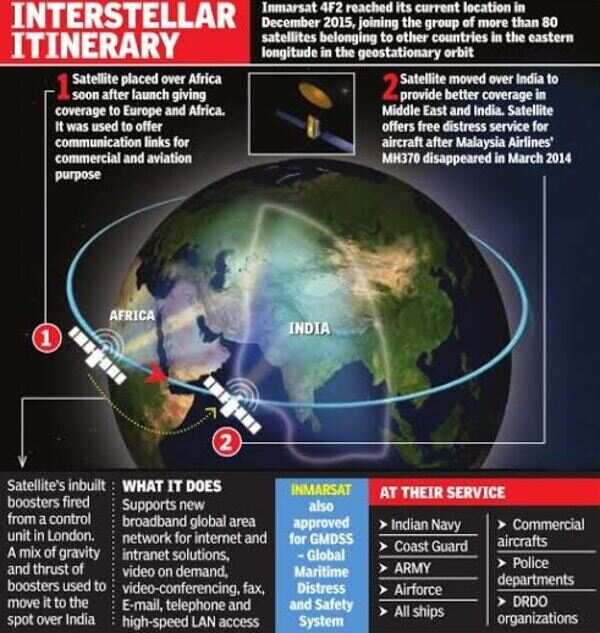- News
- Science News
- Satellite flies 4,000km in space to focus on India
This story is from July 18, 2016
Satellite flies 4,000km in space to focus on India
A satellite belonging to a London-based mobile satellite communication company recently moved over India, above the Equator, in the space after travelling more than 4,000km over several months.

A satellite belonging to a London-based mobile satellite communication company recently moved over India, above the Equator, in the space after travelling more than 4,000km over several months.
Thrusters onboard communication satellite 4F2, which is one of the 12 satellites owned by Inmarsat, were fired from the satellite control centre in London for the spacecraft to move from one slot to another.
The satellite, weighing close to 6,000kg, which was built at a cost of $250 million was launched in 2005 and was placed over Africa, providing coverage to Africa and Europe.
It was decided to be moved more than two years ago at a cost of $10million. After travelling over several months, Inmarsat 4F2 reached its current location in December 2015, joining the group of more than 80 satellites belonging to other countries in the eastern longitude in the geostationary orbit.
Maher said when the personnel at the satellite control centre fired the in-built boosters of Inmarsat 4F2, the satellite lifted up from its position about 25° east over Europe and Africa to move.
In the course of over several months, the satellite moved towards its new position also taking advantage of the gravity in the space. On reaching close to its new slot, the satellite was lowered to its new position at 63.9° east over India and the Middle East again by firing the boosters. "The virtual boxes (slots) outside the earth in the space are tightly regulated. So if we want to move one of our satellites from one location to other, we have to own the box in which we want to put the satellite," Maher said.
Orbital slots are allotted to countries and companies by International Telecommunication Union, a part of UN, headquartered in Switzerland.

Inmarsat 4F2, manufactured by EADS, was launched on November 8, 2005 from Sea Launch platform onboard Zenith 3SL. The satellite has an expected lifetime of 13 years.
"We need three satellites to cover the entire Earth. Each satellite covers one-third of the planet. We have more than three satellites," Maher said.
Communication and weather satellites are usually positioned in geostationary orbits which follow the direction of the earth's rotation so that the antennas used on Earth to communicate with them need not be moved.
Isro scientists said moving a satellite in the space may not be unusual, as they too move satellites like their INSAT series. "But ours are not moved for long distances, as our coverage is only over India. Moving over long distances is normally done for commercial satellites," said Deviprasad Karnik, Isro spokesperson. "It is a complicated and a well coordinated process initiated with small rocket engines. The satellite has to move along the earth's rotation and for longer distances, it may take several months."
Thrusters onboard communication satellite 4F2, which is one of the 12 satellites owned by Inmarsat, were fired from the satellite control centre in London for the spacecraft to move from one slot to another.
The satellite, weighing close to 6,000kg, which was built at a cost of $250 million was launched in 2005 and was placed over Africa, providing coverage to Africa and Europe.
It was decided to be moved more than two years ago at a cost of $10million. After travelling over several months, Inmarsat 4F2 reached its current location in December 2015, joining the group of more than 80 satellites belonging to other countries in the eastern longitude in the geostationary orbit.
Global government market development director Matthew Maher, who was in Chennai recently, said the satellite was moved over India from its initial slot to enhance services in India and surrounding countries including those in the Middle East. "With us, moving a satellite in the space is a rare occurrence. It is a planned event and to move in sky it takes a lot of effort," he said.
Maher said when the personnel at the satellite control centre fired the in-built boosters of Inmarsat 4F2, the satellite lifted up from its position about 25° east over Europe and Africa to move.
In the course of over several months, the satellite moved towards its new position also taking advantage of the gravity in the space. On reaching close to its new slot, the satellite was lowered to its new position at 63.9° east over India and the Middle East again by firing the boosters. "The virtual boxes (slots) outside the earth in the space are tightly regulated. So if we want to move one of our satellites from one location to other, we have to own the box in which we want to put the satellite," Maher said.
Orbital slots are allotted to countries and companies by International Telecommunication Union, a part of UN, headquartered in Switzerland.

Inmarsat 4F2, manufactured by EADS, was launched on November 8, 2005 from Sea Launch platform onboard Zenith 3SL. The satellite has an expected lifetime of 13 years.
"We need three satellites to cover the entire Earth. Each satellite covers one-third of the planet. We have more than three satellites," Maher said.
Communication and weather satellites are usually positioned in geostationary orbits which follow the direction of the earth's rotation so that the antennas used on Earth to communicate with them need not be moved.
Isro scientists said moving a satellite in the space may not be unusual, as they too move satellites like their INSAT series. "But ours are not moved for long distances, as our coverage is only over India. Moving over long distances is normally done for commercial satellites," said Deviprasad Karnik, Isro spokesperson. "It is a complicated and a well coordinated process initiated with small rocket engines. The satellite has to move along the earth's rotation and for longer distances, it may take several months."
End of Article
FOLLOW US ON SOCIAL MEDIA
